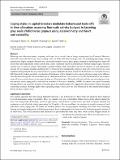Files in this item
Coping styles in capital breeders modulate behavioural trade-offs in time allocation : assessing fine-scale activity budgets in lactating grey seals (Halichoerus grypus) using accelerometry and heart rate variability
Item metadata
| dc.contributor.author | Schuert, Courtney | |
| dc.contributor.author | Pomeroy, Patrick | |
| dc.contributor.author | Twiss, Sean | |
| dc.date.accessioned | 2020-01-07T14:30:22Z | |
| dc.date.available | 2020-01-07T14:30:22Z | |
| dc.date.issued | 2020-01 | |
| dc.identifier | 258191810 | |
| dc.identifier | 447a24f4-2140-4b49-879b-086014a57233 | |
| dc.identifier | 85077054918 | |
| dc.identifier | 000519589100004 | |
| dc.identifier.citation | Schuert , C , Pomeroy , P & Twiss , S 2020 , ' Coping styles in capital breeders modulate behavioural trade-offs in time allocation : assessing fine-scale activity budgets in lactating grey seals ( Halichoerus grypus ) using accelerometry and heart rate variability ' , Behavioral Ecology and Sociobiology , vol. 74 , 8 . https://doi.org/10.1007/s00265-019-2783-8 | en |
| dc.identifier.issn | 0340-5443 | |
| dc.identifier.other | ORCID: /0000-0003-1603-5630/work/67167084 | |
| dc.identifier.uri | https://hdl.handle.net/10023/19243 | |
| dc.description | Funding: National Environmental Research Council long term funding to the Sea Mammal Research Unit at the University of St. Andrews (PPP, project title:“SMRU Long-term measurement of marine mammal population structure, dynamics and trophic interactions”, grant reference SMRU1001). | en |
| dc.description.abstract | Balancing time allocation among competing behaviours is an essential part of energy management for all animals. However, trade-offs in time allocation may vary according to the sex of the individual, their age, and even underlying physiology. During reproduction, higher energetic demands and constrained internal resources place greater demand on optimizing these trade-offs insofar that small adjustments in time-activity may lead to substantial effects on an individual’s limited energy budget. The most extreme case is found in animals that undergo capital breeding, where individuals fast for the duration of each reproductive episode. We investigated potential underlying drivers of time-activity and describe aspects of trade-offs in time-activity in a wild, capital breeding pinniped, the grey seal Halichoerus grypus, during the lactation period. For the first time, we were able to access full 24-h activity budgets across the core duration of lactation as well as characterize how aspects of stress-coping styles influence time allocation through the use of animal-borne accelerometers and heart rate monitors in situ. We found that there was a distinct trade-off in time activity between time spent Resting and Alert (vigilance). This trade-off varied with the pup’s development, date, and maternal stress-coping style as indicated by a measure of heart rate variability, rMSSD. In contrast, time spent Presenting/Nursing did not vary across the duration of lactation given the variables tested. We suggest that while mothers balance time spent conserving resources (Resting) against time expending energy (Alert), they are also influenced by the inherent physiological drivers of stress-coping styles. | |
| dc.format.extent | 17 | |
| dc.format.extent | 1072019 | |
| dc.language.iso | eng | |
| dc.relation.ispartof | Behavioral Ecology and Sociobiology | en |
| dc.subject | Maternal behaviour | en |
| dc.subject | Time-activity allocation | en |
| dc.subject | Heart rate variability | en |
| dc.subject | Pinniped | en |
| dc.subject | Lactation | en |
| dc.subject | Stress-coping styles | en |
| dc.subject | GC Oceanography | en |
| dc.subject | QH301 Biology | en |
| dc.subject | QP Physiology | en |
| dc.subject | NDAS | en |
| dc.subject.lcc | GC | en |
| dc.subject.lcc | QH301 | en |
| dc.subject.lcc | QP | en |
| dc.title | Coping styles in capital breeders modulate behavioural trade-offs in time allocation : assessing fine-scale activity budgets in lactating grey seals (Halichoerus grypus) using accelerometry and heart rate variability | en |
| dc.type | Journal article | en |
| dc.contributor.institution | University of St Andrews. School of Biology | en |
| dc.contributor.institution | University of St Andrews. Sea Mammal Research Unit | en |
| dc.contributor.institution | University of St Andrews. Marine Alliance for Science & Technology Scotland | en |
| dc.contributor.institution | University of St Andrews. Scottish Oceans Institute | en |
| dc.contributor.institution | University of St Andrews. Centre for Research into Ecological & Environmental Modelling | en |
| dc.identifier.doi | https://doi.org/10.1007/s00265-019-2783-8 | |
| dc.description.status | Peer reviewed | en |
This item appears in the following Collection(s)
Items in the St Andrews Research Repository are protected by copyright, with all rights reserved, unless otherwise indicated.

